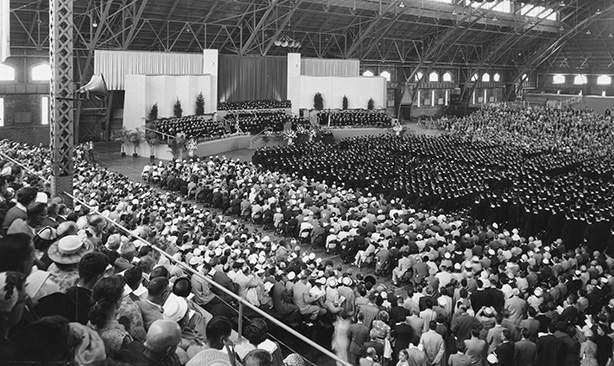CORNELL AT 150

1,731 Cornell graduates gathered in Barton Hall for Commencement in June 1960. Image: Division of Rare and Manuscript Collections.
Looking into the crystal ball: A past prediction of a future Cornell
In his June 1960 Commencement address, President Deane Waldo Malott voiced a vivid description of what a future Cornell – and Cornellians – might be like.
Malott asked the new crop of 1,731 Cornell graduates gathered in Barton Hall to imagine returning to campus for their 40th reunion in the year 2000.
"The campus seems smaller than you remembered it … the buildings more crowded, but you have at least noted with satisfaction that the Library Slope is still unconquered by stone and mortar," he said.

President Deane Waldo Malott. Image: Division of Rare and Manuscript Collections. See larger image
"Most of you, of course, have been back for many of your five-year Reunions, what with the improved six-lane highways from New York which tunnel entirely under the mountainous hills of Pennsylvania. It is an easy drive of less than two hours, using the new sources of power that have supplanted the nearly exhausted fossil fuels."
Malott went on to describe the dawn of the 21st century as "the Era of Interstellar Space," predicting that rail passenger travel throughout the nation would disappear completely by the late 1970s and that "some of you have already traveled in rocket capsules."
His predictions were gently satirical and hopeful:
"But here you are back at Cornell, meeting old friends … No one, of course, is overweight. Research at Cornell's own Graduate School of Nutrition and the Cornell Medical College in New York has been helpful in the elimination of obesity on a national scale."
"The Olin Library, which was in process of construction during your senior year, has been badly crowded for nearly a decade and the Board of Trustees … have just begun a 30-year debate on what to do about it."
"You are shocked at tuition announced for the year 2001, but I shall not disturb the equimanity of this present occasion by giving voice to the actual amount, because your sons and daughters will have been graduated from Cornell just before the new century comes."
Malott predicted the university's administration would be run via computer, care of buildings and grounds would be completely automated (with 138 pushbuttons) and the university president would be a "part-time functionary chiefly for ceremonial purposes."
At Reunion in 2000, the Class of 1960's headquarters would be an air-conditioned aluminum igloo on Lower Alumni Field, Malott described, with a "fountain gushing cold beer, piped direct in plastic glass tubes at high pressure from central storage in Ezra Cornell's old tunnel in Fall Creek Gorge. … Long rows of easy chairs and earphones are set up on the Libe Slope, so that it is possible for the old grad to sit there, adjust the headphones, put a quarter in a slot, dial the proper number, and hear any lecture given by any Cornell professor in the last 25 years."
While the university may, 40 years later, have changed in almost every aspect, it was "born out of protest to the existing order … to inaugurate drastic changes in the pattern of higher education," Malott said. He challenged the university to never become "so complacent, so self-satisfied, so intellectually arrogant that it is no longer willing to probe and to explore and to innovate and to experiment."
He left the Class of 1960 with a reminder of the loyalty and enduring devotion of Cornellians. "For universities are each linked through the years by the procession of those who are leaving to those who remain to those who shall come in the years ahead," he noted. It is the "trusteeship we have together … for the transmission of Cornell from the emerging 95 years of its past to the challenging and untold years of its future."
Other future musings
- In 1916, Murray Edward Poole, in the book "A Story Historical of Cornell University with Biographies of Distinguished Cornellians," imagined the university just 15 years in the future, in 1931. He predicted a Cornell Aerodrome on Kite Hill (steam locomotive and electric rail having been deemed too slow) and an aviation school at Cornell. The campus would be covered with many new buildings, and university grounds would be extended north nearly to Rogue's Harbor (in Lansing) and east to Dryden for experimental farm work. A New York Ship Canal would have been completed, Poole wrote. Cruisers and submarines of naval fleets, commanded by Cornellians, "lay in plain sight, with the Cornell aeroplanes hovering over them to protect them."
- In an April 1965 piece for The Cornell Daily Sun, President James A. Perkins wrote an essay in honor of the university's centennial. Cornell is entering its second century "in a strong position but with enough unfinished business to keep it busy for years to come," he wrote. He outlined many priority areas without making specific predictions, noting the difficulty of planning for growth on a campus with many competing interests. Noting the need for consensus in the academic world, he wrote: "The watchwords will have to be, therefore, understanding, patience and persistence and the greatest of these, as always, will be understanding."